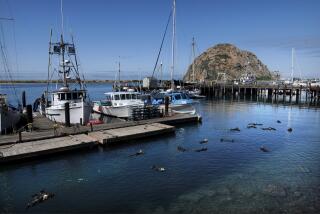Beaches Cleared of Oil but Effect on Grunion Eggs Is Still Unknown
- Share via
County health officials pronounced the waters off Seal Beach safe Friday afternoon, and Long Beach lifeguards said their beaches would reopen today, as work crews carted away the last of nearly 600 tons of sand contaminated by crude oil from Wednesday’s break in an underwater pipeline.
State Fish and Game officials said damage to wildlife appeared to be minimal--so far. But eggs spawned by grunion burrowing into the oily beaches Thursday night could be threatened, Fish and Game Patrol Lt. Mona Lisa Cole said.
Cleanup crews hired by the Exxon Corp., which owns the leaky pipeline, and wildlife officials flashed lights into the water and moved heavy equipment back and forth along the beaches until 1 a.m. Friday, hoping to keep the grunion away, Cole said.
“It didn’t work,” Cole said. “They came ashore anyway. We’ll have biologists taking samples (of the eggs) every three days, and we’ll monitor that closely.”
The grunion run was heaviest in Seal Beach, Cole said, but they spawned in Long Beach Thursday night as well. They will continue to spawn along south-facing beaches through Monday, Fish and Game biologist John Grant said.
Millions of Eggs
“They cleaned up the beach, but they can’t get the stuff down in the sand,” Grant said. “There are millions and millions of grunion eggs down there, and the oil is potentially detrimental to them.”
Normally, grunion eggs hatch in 10 to 14 days. If these eggs are harmed, Exxon could face legal action, Grant said.
“We close the grunion season each year so they can reproduce,” Grant said. “This happened in a time when they’re not supposed to be taken. . . . We want them not to be hassled.”
It is possible, Grant said, that the grunion eggs will not be harmed by the oil.
Fish and Game Department spokesman Curt Taucher said the fact that none of the grunion that came ashore to spawn died Thursday night may be cause for optimism.
“The marine environment is looking pretty good,” Taucher said. “We’ve had a few (moon) snails wash up, and we had four birds.” It was not clear, however, if the birds had died because of the oil spill or had just floated ashore through the oil after they were already dead, he said. “Our lab will be doing tests on them to try to determine that.”
Bubbling on Surface
The leak was first discovered Wednesday morning by a Seal Beach resident, who reported to the Coast Guard that he saw something bubbling to the ocean surface about 100 yards out from shore. That afternoon, after it was determined that the oil was leaking from a pipeline running from Exxon’s Belmont Island platform to an onshore processing facility, the oil company dispatched four boats to skim off as much of the 420 gallons of oil that leaked out as was possible.
On Thursday, Exxon Corp. spokeswoman Carrie Chasin said about 70% of the spilled oil had been contained and mopped up. Some of the oil, however, rode the currents and waves onto beaches that stretched from Belmont Pier in Long Beach to Anaheim Bay in Seal Beach.
Crews from IT Corp. Environmental Spill Response worked through the night Thursday and most of Friday scooping up oily sand for removal to a hazardous waste dump near Fresno by a fleet of 20-ton-capacity trucks, Exxon western division operations manager Charlie Lyons said. About 600 tons of sand were removed altogether, he said.
Early Friday afternoon, before Seal Beach waters were reopened, three teen-age surfers ignored repeated warnings by lifeguards to stay out of the ocean and wound up receiving citations from Seal Beach police.
“Shine it,” said Greg Keith, 18, of Seal Beach, just before entering the water with his buddies Tom Webb, 16, and Nathan Russell, 16, both of Long Beach. “That water’s as clean as it’s going to get. And there’s nobody out there!”
While the $250,000 cleanup job is virtually complete, divers were just beginning Friday afternoon to dig 12 feet into the ocean floor--in 54 feet of water--to uncover the leaky pipeline. Lyons said it was still unclear what caused the leak in the 20-year-old pipeline, which the company said was tested last week and showed no signs of undue wear.
A properly maintained pipeline can easily last 40 or 50 years, Lyons said.
Besides the Exxon facility on the Belmont Island platform, there are three other oil platforms in state waters off the Orange County coastline--a currently unused Chevron facility off Seal Beach, and Union Oil Co. and Shell platforms off Huntington Beach. There are also four drilling platforms in federal waters (beyond three miles) off Huntington Beach.
Also, there are four drilling platforms in state waters off Long Beach.
All of the platforms have pipelines running to onshore processing facilities, said Mike Kratovil, an oil and gas engineer with the state Department of Conservation.
The pipelines are equipped with pressure sensors that automatically shut down production if a leak is detected. Wednesday’s leak, however, was too slow to trigger that mechanism, and production had to be shut off manually once the source was discovered, Kratovil said.
More to Read
Sign up for Essential California
The most important California stories and recommendations in your inbox every morning.
You may occasionally receive promotional content from the Los Angeles Times.













